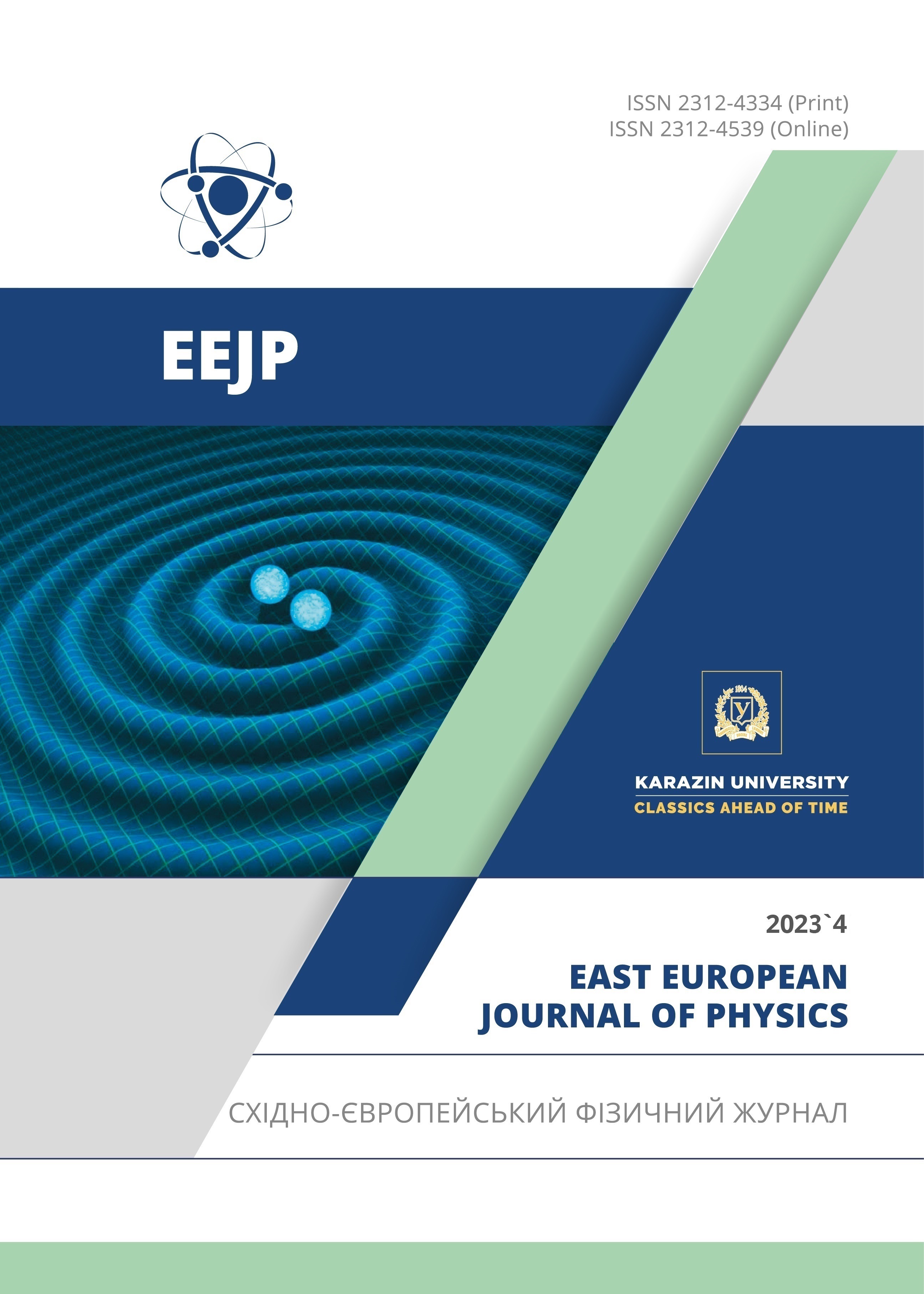Effect of Compensation Degree and Concentration of Impurity Electroactive Selenium Atoms on Current Auto-Oscillation Parameters in Silicon
Abstract
One of the crucial phenomena is auto-oscillations of current in elementary and binary (AIIIBV, AIIBVI) semiconductor materials, which allow the creation of solid-state oscillators with a wide frequency range from 10-3 to 10-6 Hz. In this paper, we show the results of a study on the effect of the degree of compensation (K) and the concentration of electroactive impurity selenium atoms on the excitation conditions and parameters (amplitude, frequency) of the auto-oscillation current associated with temperature and electrical instability in silicon. In the research, silicon doped with selenium atoms Si<Se> of identical geometrical dimensions has been used. The compensation degree of the initial boron atoms with impurity selenium atoms in the samples is in the range of K = 2NB/NSe = 0.94-1.1. It was found that excitation conditions, the amplitude and frequency of auto-oscillation current significantly vary depending on the degree of compensation of selenium atoms with boron atoms in the initial silicon. Obtained experimental results showed that the auto-oscillation current in silicon doped with impurity selenium atoms is characterized by ease of control with stable parameters (amplitude and frequency), which makes it possible based on this unique physical phenomenon to develop and create oscillatory circuits in information technology.
Downloads
References
L.L. Golik, V.E. Pakseev, Yu.I. Balkareǐ, M.I. Elinson, Yu.A. Rzhanov, and V.K. Yakushin, Fizika i Tekhnika Poluprovodnikov, 18(3), 502 (1984). https://www.mathnet.ru/eng/phts/v18/i3/p502 (in Russian).
B.A. Akimov, V.A. Bogoyavlenskii, L.I. Ryabova, V.N. Vasil’kov, and E.I. Slyn’ko, Semiconductors, 33(1), 6 (1999), https://doi.org/10.1134/1.1187637
K. Germanova, Appl. Phys. 2, 321 (1973). https://doi.org/10.1007/BF00896937
A.Sh. Abdinov, Ya.G. Akperov, V.K. Mamedov, and El’.Yu. Salaev, Sov. Phys. Semicon. 14(4), 440 (1980). (in Russian).
L.L. Golik, V.E. Pakseev, M.I. Elinson, V.K. Yakushin, and V.S. Loskutov, Fizika i Tekhnika Poluprovodnikov, 21(10), 1832 (1987). https://www.mathnet.ru/eng/phts/v21/i10/p1832 (in Russian).
K.A. Ismailov, Kh.M. Iliev, M.O. Tursunov, and B.K. Ismaylov, Semiconductor Physics, Quantum Electronics and Optoelectronics. 24(3), 255 (2021). https://doi.org/10.15407/spqeo24.03.255
G.A. Kartsivadze, Sh.M. Mirianashvili, and D.I. Nanobashvili, Fizika i Tekhnika Poluprovodnikov, 17(7), 1304 (1983), https://www.mathnet.ru/eng/phts2406. (in Russian).
I.M. Vikulin, L.F. Vikulina, and V.E. Gorbachev, Magnetosensitive semiconductor sensors, (Odesa, 2016), p. 125. (in Russian).
Z. Chen, W. Ba, J. Zhang, X. Cong, M.K. Bakhadyrkhanov, and N.F. Zikrillaev, Chinese Journal of Semiconductors, 27(9), 1582 (2006). http://www.jos.ac.cn/article/id/3e45ea73-b447-4d41-bf01-2b166472d621 (in Chinese)
M.K. Bakhadyrkhanov, Kh. Azimkhuzhaev, N.F. Zikrillaev, A.B. Sabdullaev, and É. Arzikulov, Semiconductors, 34(2), 171 (2000). https://doi.org/10.1134/1.1187929
.I. Balkerei, L.L. Golik, and M.I. Elinson, Autowave media Radioelectronic Communication, (Moscow, Znanie, 1985). p. 64. (In Russian)
L.L. Golik, M.M. Gutman, V.E. Pakseev, M.K. Bakhadyrkhanov, N.F. Zikrillaev, and A.A. Tursunov, Fizika i Tekhnika Poluprovodnikov, 21(8), 1400 (1987). https://www.mathnet.ru/rus/phts817. (in Russian)
K.V. Shalimova, Physics of Semiconductors, (Energoatomizdat, Moscow, 1989). (in Russian)
V.I. Fistulin, Introduction to Semiconductor Physics, (Vysshaya Shkola, Moscow, 1984). (in Russian)
M.K. Bakhadyrkhanov, S.B. Isamov, N.F. Zikrillaev, and M.O. Tursunov, Semiconductors, 55(6), 542 (2021). https://doi.org/10.1134/S1063782621060038
M.K. Bakhadyrkhanov, S.B. Isamov, N.F. Zikrillaev, Inorganic Materials. 50(4), 325 (2014), https://doi.org/10.1134/S0020168514040025
C. Zhaoyang, B. Weizhen, Z. Jian, M.K. Bakhadyrkhanov, and N.F. Zikrillaev, Pan Tao Tl Hsueh Pao/Chinese Journal of Semiconductors, 27 (9), 1582 (2006). http://www.jos.ac.cn//fileBDTXB/oldPDF/20060913.pdf
P.G. Kasherininov, A.V. Kichaev, and A.A. Tomasov, Semiconductors, 29(11), 1092 (1995), https://doi.org/10.48550/arXiv.0704.2703
M.K. Bakhadyrkhanov, U.Kh. Kurbanova, and N.F. Zikrillaev, Semiconductors, 33, 20 (1999), https://doi.org/10.1134/1.1187640
T.S. Kamilov, L.L. Aksenova, B.Z. Sharipov, and I.V. Ernst, Semiconductors, 49(10), 1281 (2015), https://doi.org/10.1134/S1063782615100097
M.K. Bakhadyrkhanov, N.F. Zikrillaev, and E.U. Arzikulov, Pisma v Zhurnal Tekhnicheskoi Fiziki, 17(12), 1 (1991). (in Russian).
N.F. Zikrillaev, M.M. Shoabdurakhimova, K.S. Ayupov, S.B. Isamov, and K.I. Vakhobov, Pribory, 8(266), 45 (2022). (in Russian). ID: 49457547.
M.K. Bakhadirkhanov, S.B. Isamov, N.F. Zikrillaev, Kh.M. Iliev, G.Kh. Mavlonov, S.V. Koveshnikov, and Sh.N. Ibodullaev, Surface Engineering and Appl. Electrochem. 56(6), 734 (2020). https://doi.org/10.3103/S1068375520060046
A.A. Taskin, E.G. Tishkovskii, Semiconductors, 32(11), 1162 (1998), https://doi.org/10.1134/1.1187582
M.K. Bakhadyrhanov, Sh. I. Askarov, and N. Norkulov, Phys. Stat. Solid. (a), 142, 339 (1994), https://doi.org/10.1002/pssa.2211420206
M. Bakhadyrkhanov, B. Boltaks, G. Kulikov, Sov. Phys. Solid State, 14(6), 1671 (1972).
M.S. Yunusov, A. Akhmadaliev, B.L. Oksengendler, and K.A. Begmatov, Phys. Stat. Solid. (a), 149, K 29 (1995), https://doi.org/10.1002/pssa.2211490234
Yu.A. Astrov, V.A. Shuman, L. Portsel, and A.N. Lodygin, Semiconductors, 48(3), 428 (2014), https://doi.org/10.1134/S1063782614030038
M.K. Bakhadyrkhanov, S.B. Isamov, and N.F. Zikrillaev, Russian Microelectronics, 41(6), 354(2012), https://doi.org/10.1134/S1063739712030043
A.A. Taskin, and E.G. Tishkovsky, Phys. and Technic. of Semicon. 32(11), 1306 (1998). https://journals.ioffe.ru/articles/viewPDF/34471 (in Russian)
V.N. Lozovskiy, G.S. Konstantikova, and S.V. Lozovskiy, Nanotechnology in electronics (Moscow, 2008), (in Russian)
V. Meshkalov, A. Lyubchenko, and M. Sheikman, Nonequilibrium processes in semiconductors (Kiev, 1981), (in Russian)
Copyright (c) 2023 Nurulla F. Zikrillaev, Kutup S. Ayupov, Manzura M. Shoabdurakhimova, Feruza E. Urakova, Yoldoshali A. Abduganiev, Abdujalol A. Sattorov, Latofat S. Karieva

This work is licensed under a Creative Commons Attribution 4.0 International License.
Authors who publish with this journal agree to the following terms:
- Authors retain copyright and grant the journal right of first publication with the work simultaneously licensed under a Creative Commons Attribution License that allows others to share the work with an acknowledgment of the work's authorship and initial publication in this journal.
- Authors are able to enter into separate, additional contractual arrangements for the non-exclusive distribution of the journal's published version of the work (e.g., post it to an institutional repository or publish it in a book), with an acknowledgment of its initial publication in this journal.
- Authors are permitted and encouraged to post their work online (e.g., in institutional repositories or on their website) prior to and during the submission process, as it can lead to productive exchanges, as well as earlier and greater citation of published work (See The Effect of Open Access).








